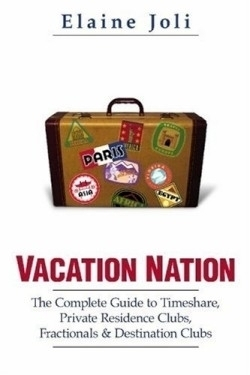Vacation Nation
People who look forward to a yearly family vacation often spend more time than they’d like searching out the best deals to fit their needs. Some like to go back to the same place, while others prefer exploring new areas each year. The concept of equity vacations evolved to give consumers what they want at affordable prices, without the hassle of repeating their search efforts each year.
Sorting through equity vacation offerings can seem daunting to potential participants. In Vacation Nation, Elaine Joli reviews the pros and cons of timeshares, private residence clubs, fractionals, and destination clubs. She shows readers how to systematically explore these options by using a method she calls the Discovery Model. This model helps readers organize the myriad details they must know to ensure that an equity vacation property will work for them. Joli examines representative equity companies, beginning with examples of their printed sales material. She then applies her method to analyzing each one, providing readers with the fine points of these properties.
The author has worked in real estate marketing in the United States and Canada for sixteen years. Her scope of experience includes large ski resorts, planned communities, resort real estate, and timeshare sales training. The Discovery Model focuses on three basic components: use right, use system, and use management plan. Joli explains use right as “the amount of time a person has the right to use the property.” She describes the use system as “the legal framework/regime and policies for the use right.” The use management plan consists of “the procedures and plans that manage how the system is going to work.”
Joli advises readers to consider the importance of being able to rent or sell their ownership share at a future date, explaining that resale of timeshares can be difficult. She writes, “Timeshare is not an investment, so don’t consider vacation ownership if that is your focus.”
Buyer motivation develops gradually when vacationers decide to purchase a fractional, which will allow them to return to the same place every year. “Very few people start out looking for a fractional property,” she writes. “Typically, they have been visiting the area for many years and expect to continue for many more.” Potential owners realize that buying into a fractional at their preferred location will cost less than acquiring and maintaining a second home.
The author presents the nuances of this complex subject objectively. Repetition of text occurs quite often, but given the detailed nature of the material, a certain amount of redundancy seems warranted. Some typographical errors were missed in the editing process.
Anyone who has attended a sales presentation given by equity property developers knows the thrill of imagined ownership of an ideal vacation retreat. This book offers readers a rational approach to considering such a purchase.
Disclosure: This article is not an endorsement, but a review. The publisher of this book provided free copies of the book and paid a small fee to have their book reviewed by a professional reviewer. Foreword Reviews and Clarion Reviews make no guarantee that the publisher will receive a positive review. Foreword Magazine, Inc. is disclosing this in accordance with the Federal Trade Commission’s 16 CFR, Part 255.

